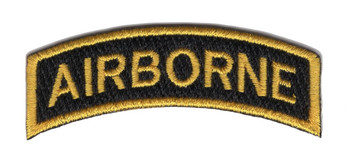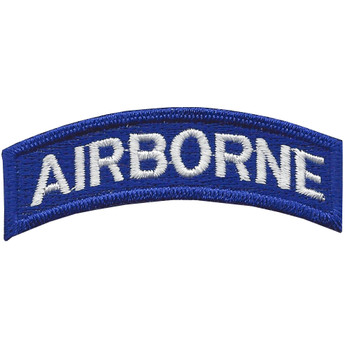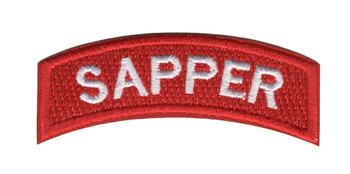Description
Army Airborne Rocker Patch Red .69" x 2.5" Embroidered Patch with Iron-On Backing
Superior Materials: Made with premium polyester thread and durable twill fabric, ensuring long-lasting color and strength.
Advanced Embroidery Technology: Crafted using the most advanced embroidery machinery, guaranteeing intricate detail, sharp lines, and consistent quality every time.
Easy Iron-On Application: Features a heat-activated adhesive backing for quick, no-sew attachment. Simply position, iron, and press for a secure bond.
Versatile Use: Perfect for personalizing jackets, backpacks, uniforms, or any fabric surface that needs a touch of personality.
Durable and Washable: Designed to withstand everyday wear and occasional washing without fading or fraying.
Formations & Origins
The “Airborne” rocker patch isn’t just a strip of fabric—it’s a badge of courage, pride, and grit earned by some of the most elite soldiers in the United States Army. The red variant is typically seen as a stylized or commemorative version, often used on morale gear or collectible displays.
Airborne units were born out of necessity during World War II, with the first U.S. Army parachute test platoon forming in 1940. By 1942, the 82nd and 101st Airborne Divisions were activated, establishing the foundation of America’s airborne combat force. These divisions became known for their high-risk, high-reward missions—parachuting behind enemy lines, disrupting supply chains, and seizing key objectives in the dead of night.
Notable Commanders
Throughout history, Airborne units have been led by legendary figures. Major General James M. Gavin, known as “The Jumping General,” commanded the 82nd Airborne during WWII and jumped into combat alongside his men. General Maxwell Taylor of the 101st Airborne also made history during D-Day and the Battle of the Bulge.
These commanders shaped a new kind of soldier—fierce, independent, and fearless. Airborne leaders are known for leading from the front, parachuting into the unknown with their troops and rallying under fire.
Major Campaigns/Operations
Airborne forces have been at the tip of the spear in nearly every major American conflict:
-
World War II: D-Day (Normandy), Operation Market Garden, and the Battle of the Bulge
-
Korea: Rapid-deployment operations and security missions
-
Vietnam: Airborne units operated in support of special operations and rapid-reaction forces
-
Grenada and Panama: Led swift invasion forces, securing airfields and neutralizing hostile targets
-
Iraq and Afghanistan: Deployed in both full-scale assaults and counterinsurgency operations
-
Global Response Force (present day): Airborne units like the 82nd remain on 18-hour standby for worldwide deployment
Specialized Role/Equipment
Airborne troops are specially trained to deploy by parachute from aircraft into combat zones. Their role is rapid assault—seizing key terrain, disrupting enemy command, and holding ground until reinforced.
They’re equipped light and fast: M4 carbines, machine guns, radios, and enough supplies to hold a position until linkup with heavier forces. Airborne units often coordinate closely with Air Force airlift wings, using aircraft like the C-130 Hercules and C-17 Globemaster.
Training at Airborne School in Fort Moore (formerly Fort Benning) is intense and unforgiving. The final test: five jumps from a military aircraft, including one night jump. Earn your wings, and you’ve joined a brotherhood that spans generations.
Acts of Heroism
Airborne history is overflowing with heroism. Paratroopers have jumped into flak-filled skies and landed in enemy-held territory with no support. At Normandy, paratroopers were scattered miles off-course yet still completed their missions—blowing bridges, capturing crossroads, and sowing chaos behind German lines.
During the Battle of the Bulge, the 101st Airborne held Bastogne against overwhelming German forces in freezing conditions, refusing to surrender. When asked for terms, Brigadier General Anthony McAuliffe famously responded with a single word: “Nuts.”
In Iraq, Afghanistan, and beyond, Airborne troops have assaulted compounds, rescued hostages, and fought through ambushes—bringing speed, violence of action, and precision to every mission.
Legacy & Notable Achievements
To wear the “Airborne” tab is to wear the weight of legacy. It's earned through sweat, fear, and the willingness to leap from the sky into the unknown. The red version of this patch, while not standard issue, honors that legacy—whether worn for pride, remembrance, or tradition.
Airborne units are among the most highly decorated in the U.S. military. Their legacy lives on in the stories of D-Day veterans, the grit of Korean War jumps, the firebases of Vietnam, and the modern battlegrounds of the Middle East.
To wear the red Airborne rocker is to say you respect what it means to earn it. Whether you jumped or supported the ones who did, that patch is a symbol of those who never waited for the fight—they dropped straight into it.






